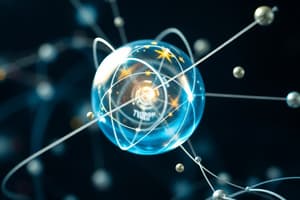Podcast
Questions and Answers
Which branch of physics focuses on the motion of objects and the forces acting on them?
Which branch of physics focuses on the motion of objects and the forces acting on them?
- Electromagnetism
- Classical Mechanics (correct)
- Thermodynamics
- Quantum Mechanics
What fundamental principle explains that energy cannot be created or destroyed, only transformed?
What fundamental principle explains that energy cannot be created or destroyed, only transformed?
- Conservation of energy (correct)
- Thermodynamic laws
- Newton's laws
- Quantum theory
Which equation correctly represents kinetic energy?
Which equation correctly represents kinetic energy?
- KE = mgh
- KE = mv
- KE = 1/2 mv² (correct)
- KE = Fd
What is the SI unit of force?
What is the SI unit of force?
Which type of wave is characterized by oscillations that are perpendicular to the direction of wave propagation?
Which type of wave is characterized by oscillations that are perpendicular to the direction of wave propagation?
What phenomenon describes the bending of light as it passes from one medium to another?
What phenomenon describes the bending of light as it passes from one medium to another?
Mass-energy equivalence is best represented by which equation?
Mass-energy equivalence is best represented by which equation?
Which of the following is NOT a key concept in thermodynamics?
Which of the following is NOT a key concept in thermodynamics?
Flashcards are hidden until you start studying
Study Notes
Fundamental Concepts of Physics
- Definition: Physics is the scientific study of matter, energy, and the interactions between them.
Key Branches of Physics
-
Classical Mechanics
- Studies the motion of objects and the forces acting on them.
- Key laws: Newton's laws of motion.
-
Electromagnetism
- Explores electric charges, magnetic fields, and their interactions.
- Key phenomena: electric currents, gravitational and magnetic fields.
-
Thermodynamics
- Deals with heat, work, and energy transfer.
- Key laws: laws of thermodynamics (e.g., conservation of energy).
-
Quantum Mechanics
- Studies the behavior of matter and energy at atomic and subatomic levels.
- Concepts: wave-particle duality, uncertainty principle.
-
Relativity
- Introduced by Albert Einstein, includes special and general relativity.
- Key ideas: time dilation, mass-energy equivalence (E=mc²).
Important Principles
-
Conservation Laws:
- Conservation of mass, energy, momentum, and angular momentum.
-
Forces:
- Fundamental forces: gravitational, electromagnetic, strong nuclear, and weak nuclear forces.
-
Motion:
- Types: linear, rotational, and periodic motion.
- Key equations: kinematics and dynamics equations.
Measurement and Units
-
SI Units:
- Mass: kilogram (kg)
- Length: meter (m)
- Time: second (s)
- Force: newton (N)
- Energy: joule (J)
-
Measurement Tools:
- Stopwatch (time), balance scale (mass), meter stick (length).
Concepts of Energy
- Kinetic Energy: Energy of motion, given by KE = 1/2 mv².
- Potential Energy: Stored energy based on position, PE = mgh (gravitational potential energy).
Waves and Oscillations
-
Types of Waves:
- Transverse (e.g., light) and longitudinal (e.g., sound).
-
Wave Properties:
- Amplitude, wavelength, frequency, speed.
Light and Optics
- Nature of Light: Exhibits both wave-like and particle-like properties (photons).
- Reflection and Refraction: Laws governing the behavior of light at boundaries.
Modern Physics
- Nuclear Physics: Studies the constituents and interactions of atomic nuclei.
- Particle Physics: Investigates fundamental particles and their interactions through accelerators.
Practical Applications
- Engineering, medicine (medical imaging), space exploration, and renewable energy technologies.
Conclusion
- Physics provides fundamental insights into the natural world and is essential for advancements in technology and scientific understanding.
Physics: The Study of Matter and Energy
- Physics is the study of matter, energy, and how they interact.
- It encompasses various branches, each exploring specific aspects of the natural world.
Key Branches of Physics
- Classical Mechanics: Focuses on how objects move and the forces that influence their motion. It follows Newton's laws of motion.
- Electromagnetism: Deals with electric charges, magnetic fields, and their interactions. It explains phenomena like electric currents and gravitational and magnetic fields.
- Thermodynamics: Studies heat, work, and energy transfer. Key concepts include the laws of thermodynamics, such as the conservation of energy.
- Quantum Mechanics: Examines the behavior of matter and energy at the atomic and subatomic levels. It incorporates concepts like wave-particle duality and the uncertainty principle.
- Relativity: Developed by Albert Einstein, including special and general relativity, which explores the relationship between space, time, gravity, and mass. Key ideas include time dilation and mass-energy equivalence (E=mc²).
Important Principles in Physics
- Conservation Laws: Fundamental principles stating that certain quantities remain constant in a closed system. These include the conservation of mass, energy, momentum, and angular momentum.
- Forces: Interactions that cause changes in motion or shape of an object. Fundamental forces include:
- Gravitational Force: Attracts objects with mass towards each other.
- Electromagnetic Force: Acts between electrically charged objects.
- Strong Nuclear Force: Holds the nucleus of an atom together.
- Weak Nuclear Force: Involved in radioactive decay.
- Motion: Change in position over time. Types include:
- Linear Motion: Movement in a straight line.
- Rotational Motion: Movement around a fixed axis.
- Periodic Motion: Repetitive motion, like oscillations.
- Key equations describe the relationships between position, velocity, acceleration, and time.
Measurement and Units
- SI Units: The International System of Units, a standardized system used for measurement.
- Mass: kilogram (kg)
- Length: meter (m)
- Time: second (s)
- Force: newton (N)
- Energy: joule (J)
- Measurement Tools: Devices used for specific measurements:
- Stopwatch: measures time.
- Balance scale: measures mass.
- Meter stick: measures length.
Concepts of Energy
- Kinetic Energy: The energy an object possesses due to its motion. Calculated as KE = 1/2 mv² (where m is mass and v is velocity).
- Potential Energy: Energy stored based on an object's position or configuration.
- Gravitational Potential Energy: PE = mgh (where m is mass, g is acceleration due to gravity, and h is height).
Waves and Oscillations
- Types of Waves: Disturbances that transfer energy through a medium or space.
- Transverse Waves: The motion of the medium is perpendicular to the wave's direction of travel (e.g., light).
- Longitudinal Waves: The motion of the medium is parallel to the wave's direction of travel (e.g., sound).
- Wave Properties: Characteristics of waves:
- Amplitude: The maximum displacement of the medium from its rest position.
- Wavelength: The distance between two consecutive crests or troughs.
- Frequency: The number of waves passing a point per unit of time.
- Speed: The rate at which a wave travels.
Light and Optics
- Nature of Light: Exhibits both wave-like and particle-like properties. It can behave as a wave (e.g., diffraction) and a particle (e.g., photoelectric effect). Light particles are called photons.
- Reflection and Refraction: How light interacts with surfaces.
- Reflection: Light bounces off a surface.
- Refraction: Light bends as it passes from one medium to another (e.g., from air to water).
Modern Physics
- Nuclear Physics: Focuses on the structure and properties of the atomic nucleus.
- Particle Physics: Studies fundamental particles and their interactions. Uses particle accelerators to investigate these particles.
Practical Applications of Physics
- Physics principles find wide applications in various fields, including:
- Engineering: Designing and building structures, machines, and systems.
- Medicine: Medical imaging, radiation therapy, and other medical technologies.
- Space Exploration: Launching and operating spacecraft, understanding the universe.
- Renewable Energy Technologies: Developing sustainable energy sources like solar and wind power.
Conclusion
- Physics plays a central role in our understanding of the natural world. It provides a framework for understanding how things work at both macroscopic and microscopic levels. This understanding leads to advancements in technology and scientific knowledge.
Studying That Suits You
Use AI to generate personalized quizzes and flashcards to suit your learning preferences.




